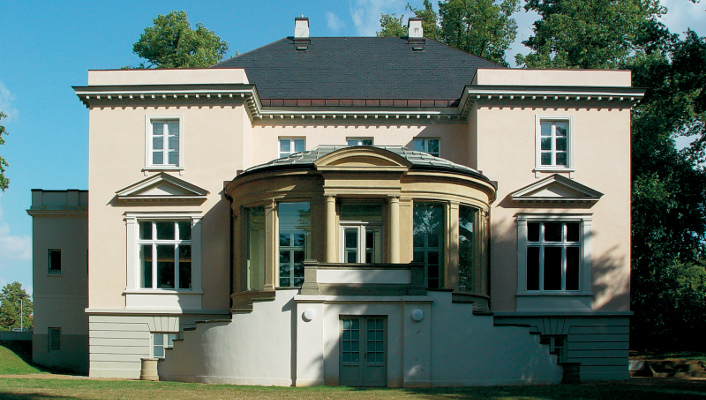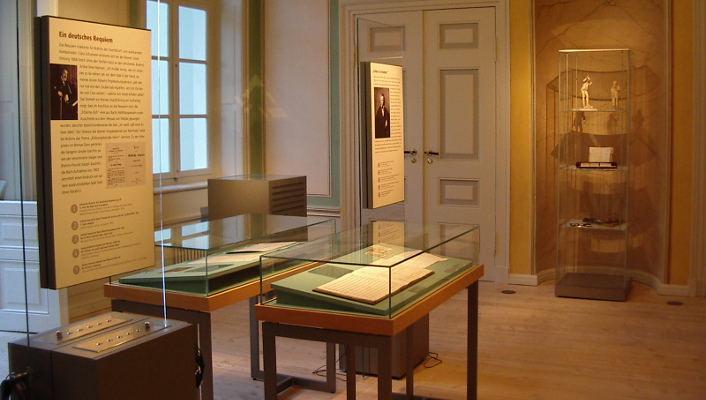



Brahms-Institut an der Musikhochschule Lübeck
Jerusalemsberg 4
23568 Lübeck
Telefon +49.451.1505414
Mittwoch und Samstag 14–18 Uhr,
Führungen und Sondertermine auf Anfrage
Mitte Dezember bis Anfang Februar geschlossen
Das Brahms-Institut an der Musikhochschule Lübeck beherbergt eine der größten und vielseitigsten Brahms-Sammlungen weltweit. Die Schwerpunkte konzentrieren sich – neben Johannes Brahms – auf Robert und Clara Schumann, Theodor Kirchner und Joseph Joachim sowie auf das musikhistorische Umfeld. Die Bestände umfassen in erster Linie Quellen musikalischer Werke: kostbare Handschriften, Stichvorlagen, Erst- und Frühdrucke. Hinzu kommen umfangreiche Briefschaften, zahlreiche zeitgenössische Fotos, Bilder und Zeichnungen sowie einmalige Konvolute mit Programmzetteln zu wichtigen Ur-, Erst- und Folgeaufführungen von Brahms-Werken. Das Institut ist in der repräsentativen Villa Eschenburg untergebracht. Der glänzend restaurierte Festsaal bietet den stilvollen Rahmen für Konzerte, Themenabende, Vorträge und Präsentationen. Im ebenfalls historischen Gartensaal der Villa ist ein Ausstellungsraum entstanden, der Leben und Werk von Johannes Brahms anschaulich werden lässt. Zu sehen sind kostbare und teilweise unveröffentlichte Musikhandschriften, Fotos, Briefe, Konzertprogramme und andere Schätze.
Ausführliche Informationen und das digitale Archiv unter: www.brahms-institut.de
Deutschland verfügt über musikalische Traditionen und Nachlässe von außerordentlichem Wert: Händel, Schütz und Bach, Beethoven, Mendelssohn, Schumann, Brahms und Wagner sind - um nur einige Namen zu nennen - weltweit bekannte und geschätzte Komponisten. Ihr Wirken hat eine einzigartige Musiklandschaft wesentlich mitgeformt.
Zahlreiche Orchester, Chöre und Ensembles, renommierte Musikfestivals und -reihen, Musikerhäuser mit Museen, öffentliche Archive und Bibliotheken, aber auch private Sammlungen bewahren ihr musikalisches Erbe.
Diesen unschätzbaren Fundus gilt es immer wieder neu zu beleben und für die Gegenwart zu erschließen. Den in der Arbeitsgemeinschaft Musikermuseen Deutschlands zuusammengeschlossenen Häusern kommt dabei eine wichtige Rolle zu. In ihnen begegnen wir dem Werk von Musikern und Komponisten, die die Kulturnation Deutschland außerordentlich bereichert haben. Über das individuelle Portrait, über die Vermittlung des einzelnen Œuvres hinaus tragen die Musikermuseen aber auch zur Pflege musikalischer Tradition insgesamt bei. Die vorliegende Broschüre unterstreicht diesen Aspekt der Zusammenschau, und sie lädt zu einer Reise in die Musikgeschichte Deutschlands ein. Ich wünsche diesem Reiseführer regen Gebrauch und eine große Resonanz.
Bernd Neumann, MdB
Staatsminister bei der Bundeskanzlerin
Der Beauftragte der Bundesregierung für Kultur und Medien
Zitat: Vorwort zur Broschüre der Arbeitsgemeinschaft "Musikermuseen in Deutschland", 2007.